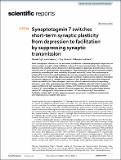Synaptotagmin 7 switches short-term synaptic plasticity from depression to facilitation by suppressing synaptic transmission
Author(s)
Fujii, Takaaki; Sakurai, Akira; Littleton, J Troy; Yoshihara, Motojiro
DownloadPublished version (1.302Mb)
Publisher with Creative Commons License
Publisher with Creative Commons License
Creative Commons Attribution
Terms of use
Metadata
Show full item recordAbstract
© 2021, The Author(s). Short-term synaptic plasticity is a fast and robust modification in neuronal presynaptic output that can enhance release strength to drive facilitation or diminish it to promote depression. The mechanisms that determine whether neurons display short-term facilitation or depression are still unclear. Here we show that the Ca2+-binding protein Synaptotagmin 7 (Syt7) determines the sign of short-term synaptic plasticity by controlling the initial probability of synaptic vesicle (SV) fusion. Electrophysiological analysis of Syt7 null mutants at Drosophila embryonic neuromuscular junctions demonstrate loss of the protein converts the normally observed synaptic facilitation response during repetitive stimulation into synaptic depression. In contrast, overexpression of Syt7 dramatically enhanced the magnitude of short-term facilitation. These changes in short-term plasticity were mirrored by corresponding alterations in the initial evoked response, with SV release probability enhanced in Syt7 mutants and suppressed following Syt7 overexpression. Indeed, Syt7 mutants were able to display facilitation in lower [Ca2+] where release was reduced. These data suggest Syt7 does not act by directly sensing residual Ca2+ and argues for the existence of a distinct Ca2+ sensor beyond Syt7 that mediates facilitation. Instead, Syt7 normally suppresses synaptic transmission to maintain an output range where facilitation is available to the neuron.
Date issued
2021Department
Picower Institute for Learning and Memory; Massachusetts Institute of Technology. Department of Biology; Massachusetts Institute of Technology. Department of Brain and Cognitive SciencesJournal
Scientific Reports
Publisher
Springer Science and Business Media LLC